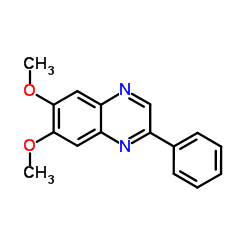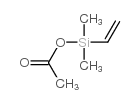Tyrphostin AG 1296

Tyrphostin AG 1296 structure
|
Common Name | Tyrphostin AG 1296 | ||
|---|---|---|---|---|
| CAS Number | 146535-11-7 | Molecular Weight | 266.295 | |
| Density | 1.2±0.1 g/cm3 | Boiling Point | 420.2±40.0 °C at 760 mmHg | |
| Molecular Formula | C16H14N2O2 | Melting Point | N/A | |
| MSDS | N/A | Flash Point | 151.8±17.6 °C | |
Use of Tyrphostin AG 1296Tyrphostin AG1296 is a potent and selective inhibitor of platelet-derived growth factor receptor (PDGFR), with an IC50 of 0.8 μM. Tyrphostin AG1296 inhibits signaling of human PDGF α- and β-receptors as well as of the related stem cell factor receptor (c-Kit). Tyrphostin AG1296 is also a potent inhibitor of FLT3, with an IC50 in the micromolar range[1][2][3]. |
| Name | 6,7-dimethoxy-2-phenylquinoxaline |
|---|---|
| Synonym | More Synonyms |
| Description | Tyrphostin AG1296 is a potent and selective inhibitor of platelet-derived growth factor receptor (PDGFR), with an IC50 of 0.8 μM. Tyrphostin AG1296 inhibits signaling of human PDGF α- and β-receptors as well as of the related stem cell factor receptor (c-Kit). Tyrphostin AG1296 is also a potent inhibitor of FLT3, with an IC50 in the micromolar range[1][2][3]. |
|---|---|
| Related Catalog | |
| Target |
PDGFRα PDGFRβ |
| In Vitro | Tyrphostin AG1296 (0.625-20 μM; 72 h) suppresses viability of PLX4032-resistant melanoma cells[4]. Tyrphostin AG1296 (2.5-20 μM; 48 h) induces apoptosis of A375R cells[4]. Tyrphostin AG1296 (5 and 20 μM; 2 h) inhibits PDGFR phosphorylation in A375R cells[4]. Tyrphostin AG1296 (0.0625-1 μM; 8 h) inhibits migration of A375R cells[4]. Cell Viability Assay[4] Cell Line: PLX4032-resistant cell lines (A375R and SK-MEL-5R) Concentration: 0.625, 1.25, 5, 20 μM Incubation Time: 72 h Result: Reduced the viability of both PLX4032-sensitive and PLX4032-resistant cell lines. Apoptosis Analysis[4] Cell Line: A375R cells Concentration: 2.5, 5, 10, 20 μM Incubation Time: 48 h Result: Induced dramatic apoptosis in A375R cells. Western Blot Analysis[4] Cell Line: A375R cells Concentration: 5, 20 μM Incubation Time: 2 h Result: Inhibited phosphorylation of both PDGFR-α and PDGFR-β. |
| In Vivo | Tyrphostin AG1296 (40 and 80 mg/kg; i.p. daily for two weeks) suppresses A375R tumor growth in vivo[4]. Tyrphostin AG1296 (2 mg/kg; i.p. every other day for 3 weeks) inhibits the atherosclerotic plaque progression and enhances plaque stability by inhibiting inflammatory responses, reducing the expression of matrix metalloproteinases and promoting macrophages from proinflammatory phenotype to anti-inflammatory phenotype[5]. Animal Model: Nud/nud mice are injected with A375R cells[4] Dosage: 40, 80 mg/kg Administration: I.p. daily for two weeks Result: Led to an intermediate level of tumor growth suppression at dose of 40 mg/kg, and significant inhibition of A375R tumor growth at dose of 80 mg/kg. Well tolerated by healthy mice without significant signs of overt toxicity or weight loss. |
| References |
| Density | 1.2±0.1 g/cm3 |
|---|---|
| Boiling Point | 420.2±40.0 °C at 760 mmHg |
| Molecular Formula | C16H14N2O2 |
| Molecular Weight | 266.295 |
| Flash Point | 151.8±17.6 °C |
| Exact Mass | 266.105530 |
| PSA | 44.24000 |
| LogP | 3.76 |
| Vapour Pressure | 0.0±1.0 mmHg at 25°C |
| Index of Refraction | 1.618 |
| Storage condition | 2-8°C |
| WGK Germany | 3 |
|---|
|
~% 
Tyrphostin AG 1296 CAS#:146535-11-7 |
| Literature: Gazit, Aviv; App, Harald; McMahon, Gerald; Chen, Jefferey; Levitzki, Alexander; Bohmer, Frank D. Journal of Medicinal Chemistry, 1996 , vol. 39, # 11 p. 2170 - 2177 |
|
~% 
Tyrphostin AG 1296 CAS#:146535-11-7 |
| Literature: Gazit, Aviv; App, Harald; McMahon, Gerald; Chen, Jefferey; Levitzki, Alexander; Bohmer, Frank D. Journal of Medicinal Chemistry, 1996 , vol. 39, # 11 p. 2170 - 2177 |
| Precursor 3 | |
|---|---|
| DownStream 0 | |
| 6,7-Dimethoxy-2-phenylquinoxaline |
| Quinoxaline, 6,7-dimethoxy-2-phenyl- |
| Quinoxaline,6,7-dimethoxy-2-phenyl |
| 2-phenyl-6,7-dimethoxyquinoxaline |
| Tyrphostin AG-1296 |
| 2-phenyl-6,7-dimetoxyquinoxaline |
| MFCD00270913 |
| 6,7-Dimethoxy-3-phenylquinoxaline |


